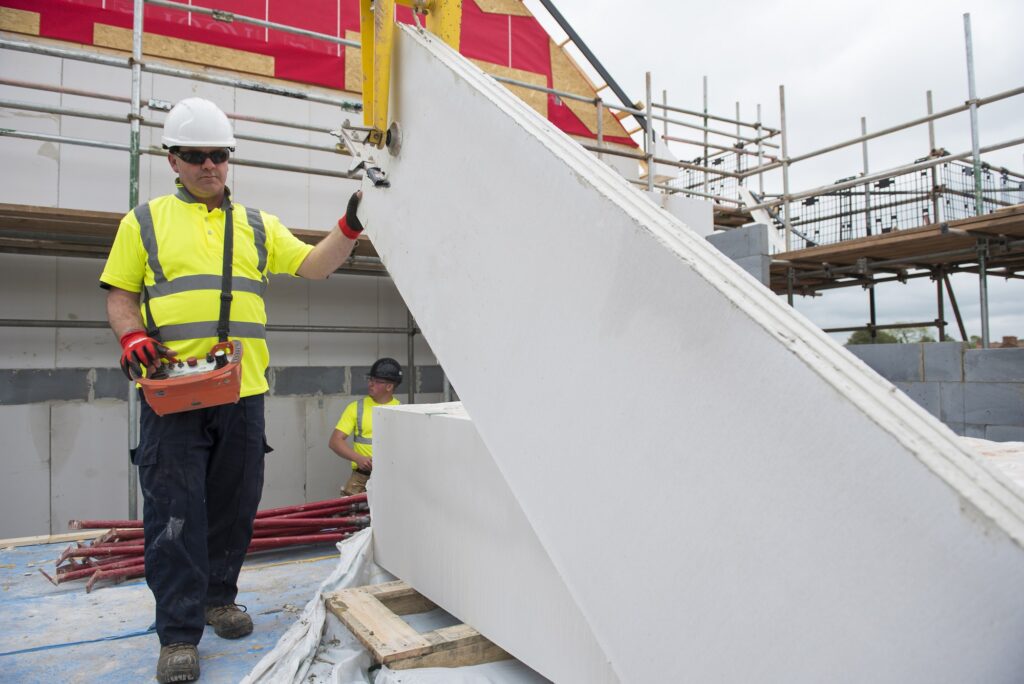MMC: increasing accreditation required

Modern Methods of Construction will be key to housebuilding of the future, but MMC suppliers need to provide an increasing range of independently verified information to meet industry requirements.
Technical performance comes top of the list. All MMC homes, however they are assembled, must comply with the same quality assurance standards, accreditation and legislation that are applicable to homes built onsite.
In addition to onsite standards, however, there are two accreditation schemes developed specifically for MMC systems. These provide additional assurance to housebuilders and developers that a particular MMC system has been assessed to meet a defined set of standards. The two schemes are Build Offsite Property Assurance Scheme (BOPAS) and NHBC Accepts.
Saint-Gobain Roofspace Solutions i-House panellised MMC system, for example, is accredited by BOPAS, while its Scotframe Timber Engineering Thermistud and Val-U-Therm PLUS timber frame panels have both been accredited under the NHBC Accepts scheme as meeting NHBC Standards. Both schemes provide assurance to the housebuilder, the future homeowners and the mortgage lenders of the integrity and durability of these Saint-Gobain MMC systems.
Meeting zero carbon ambitions
Increasingly stringent Building Regulations (notably Part L) have done a lot to reduce the energy requirements of homes in use. To meet zero carbon targets, however, the homes of the future will need also to account for their Whole Life Carbon (WLC).
A home’s WLC is key to it becoming net zero carbon. There is no point in building the most energy efficient home possible if the carbon emissions from the manufacture of the products used in its construction are excessive. Similarly, a focus on minimising the carbon embodied in the fabric of a home is pointless if the subsequent emissions from heating that home in operation are also excessive.
The net zero goal is becoming a focus for developers, not least because of the growing number of climate-conscious investors concerned about the carbon emissions from companies in their investment portfolio, which includes manufacturers like Saint-Gobain and the housebuilders.
Zero carbon and the supply chain
The response from the volume housebuilders is commitments to meeting carbon reduction targets. To do this, they need their suppliers to engage in carbon reduction programmes, a process that begins with the accurate calculation and reporting on embodied carbon.
This information is most commonly provided in an Environmental Product Declaration (EPD). This document reports on a product’s environmental impact throughout its life cycle – from raw material extraction to its eventual disposal or reuse.
EPDs are always third-party verified and follow a set of ISO standards as well as specific Product Category Rules.
Product Category Rules provide the requirements and guidelines for developing an EPD for a specific product category. They ensure that functionally similar products are assessed in the same way and report comparable information by following the same calculation methods and reporting guidelines.
Product EPDs are evolving but are increasingly significant. So far, they are being driven by the housebuilders looking to reduce the carbon emissions associated with their businesses. In the future it is more than likely that Building Regulations will mandate WLC assessments and limits.
Saint-Gobain and zero carbon
Like most responsible manufacturers Saint-Gobain is working hard to understand its carbon emissions and to reduce them. We have made a commitment to achieve net zero carbon emissions by 2050. We are also committed to producing EPDs where product category rules have already been established and to working with others to put in place product category rules where these have yet to be established. This will ensure housebuilders and designers are aware of the amount carbon embodied in our products.
We are on that journey. For Saint-Gobain manufactured products such as i-Roof, where we have total control over our Scope 1 and Scope 2 emissions, we have already produced an EPD. For MMC systems such as i-House, which incorporate other manufacturers’ products, we are reliant on our supply chain (Scope 3 emissions) to commit to EPDs. In the case of i-House our vertical wall panel supplier H+H has already been completed an EPD.
Accreditation and verification are dynamic areas for MMC. The picture is , one that is still evolving and will continue to evolve as manufacturing process, sources of raw materials, transportation methods and recycling all impact a product or system’s carbon footprint. It is a carbon journey we have committed to, and one in which we are determined to reach our net zero destination.


